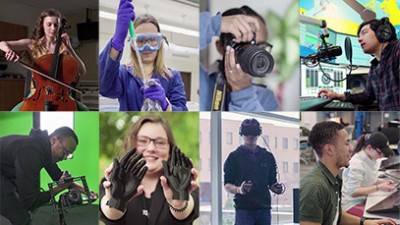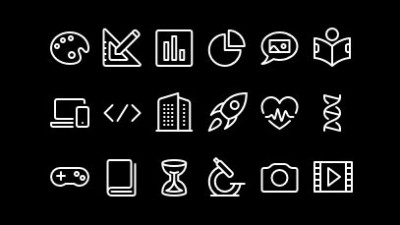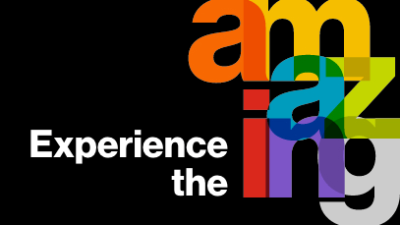New media is a dynamic, ever-changing industry that integrates communication, computing, design, and technology to create highly interactive user experiences on all types of digital devices, from tablets and computers to smartphones, smart TVs, and gaming systems. How do you launch a career in digital media? It’s all about pairing the right RIT major to the things you like to do.
What is New Media?
Every time you use a computer, tablet, smartphone, smart TV, or gaming system, you’re engaging with new media. New media is anything that integrates communication, computing, and technology—from social media (Facebook, Instagram) and streaming services (Spotify, Hulu, Amazon Prime) to highly interactive digital technologies like wearables (Apple Watch, FitBit), virtual reality, augmented reality, and games.
To make new media engaging and interactive, you need professionals that can create a range of digital assets, including video and audio, photos and infographics, motion and broadcast graphics, computer graphics, digital illustrations, 2D and 3D models, interactive designs, and digital designs. Interactivity is what brings these assets alive. And that interactivity can be in the form of virtual reality, augmented reality, games, websites, apps, and more.
Whether you’re into the digital media design, graphic design, or illustration side of new media, find yourself drawn to the development and implementation of computing and digital media technologies, or you want to mix your writing and visual communication expertise with skills in graphic design, illustration, or digital asset management, RIT offers a host of degrees in digital media that can fit your professional aspirations and launch your career in digital media.

New Media Career Paths
Careers in digital media are growing like never before. RIT offers a portfolio of dynamic undergraduate majors in new media that combines the newest digital tech and software with the best in new media technology, interactive design, digital media design, and new media art—all to prepare you to become the next trailblazer in digital media.
- 3D Digital Design BFA
3D digital designers use their artistry to create virtual elements featured in everything from games and movies to visualizations and augmented reality. In the 3D digital design major, you’ll use professional 3D software to create assets for games, virtual reality, medical and scientific simulations, data visualization, movies, motion or broadcast graphics, instructional media, and more. Digital design courses include computer graphics for games, visual design, 3D and 4D design, digital graphics, environmental design, game development, interactive design, 3D imaging, and more. With a degree in 3D digital design, you’ll be prepared for careers as a special effects artist, digital art designer, digital sculptor, user interface artist, concept artist, user interface artist, motion graphics artist, and more. - Graphic Design BFA
Graphic designers are visual problem-solvers who use a wide variety of concepts and media platforms to inform, direct, promote, entertain, engage, and educate specific audiences. In the graphic design major, you’ll be exposed to a full range of topics throughout your course work that aid in developing your skills as a multifaceted graphic designer. These include information design, web and interaction design, branding and identity design, design systems, exhibit and wayfinding design, user experience design, and professional practices. Careers await in positions such as visual designer, interactive designer, graphic designer, UI/UX designer, and more. - Humanities, Computing, and Design BS
While the world will always need skilled writers, sociologists, psychologists, journalists, teachers, lawyers, and others whose background is found in the liberal arts and humanities, technology has impacted these disciplines in profound ways. The humanities, computing, and design degree takes an interdisciplinary look at the impact of technology on three distinct areas–the liberal arts (understanding how technology impacts the people and societies who use it), computing (developing technical skills needed to create digital tools and manage data), and art and design (understanding how design impacts user experience and data visualization). By combining these skills sets, you’ll be prepared for careers as a digital project manager, digital marketing specialist, or editor for web and emerging media for a range of organizations. - Human-Centered Computing BS
Human-centered computing blends computing, psychology, and design into one major that responds to an increased need for software and digital devices to become more intuitive and usable. The human-centered computing degree focuses on understanding the ways in which people use and interact with technology. This, in turn, influences how both hardware (devices) and software interact with digital media that is designed to engage users, such as interactivity and interaction. This major prepares you for dynamic careers as a usability analyst, human factors engineer, information architect, interaction designer, and user experience (UX) designer. - Illustration BFA
Mixing traditional drawing skills with the latest in digital imaging technologies to create powerful visual communications—this is today’s illustration degree. RIT’s illustration major prepares you for a variety of careers within the visual communication field—a field that now includes 2D and 3D design, dimensional illustration, and digital illustration. Illustrators find themselves working as games asset illustrators, editorial illustrators, character designers, new media artists, multimedia illustrators, motion graphics artists, or visual developers. - New Media Design BFA
Every day, millions of people engage in interactive digital experiences, from smartphones and smart TVs to tablets, wearables, game systems, and more. In the new media design degree, you’ll explore dynamic aspects of digital design–visual design, user experience design, interaction, motion graphics, and technology—that give you the skills you need to create captivating, interactive media. Courses explore visual design foundations, 2D and 4D design, animation, information design, user interface design, user experience design, 3D modeling, motion graphics, web and multimedia technologies, usability research, and programming. Your impressive portfolio of projects will show off your skills for a career as a motion graphics designer, web developer, art director, interaction designer, content design analyst, and more. - New Media Interactive Development BS
Students interested in the computer science aspect of new media might find the new media interactive development major to be a perfect fit. You’ll learn the programming and computing skills for multiple interfaces, as well as the interactive design skills needed to create outstanding user interaction. Course work explores new and evolving digital technologies—the internet, social software, hand-held and wearable devices, touch and gestural interfaces, the Internet of Things, virtual reality, augmented reality, and more—and how to create interactive and engaging digital experiences for each. You’ll be well prepared for positions such as interactive developer, web developer, mobile app developer, user experience (UX) developer, and more. - Print and Graphic Media Technology BS
Today’s graphic communication professionals serve the robust marketing communications, publishing, and packaging graphics industries by creating and producing integrated media across a range of platforms. RIT’s media arts and technology degree prepares you to manage content from concept through distribution across print, web, mobile, and social media. The major includes courses in website creation and production, photography and imaging, professional and technical writing, database publishing, information architecture, multimedia strategies, digital asset management, and more. This combination provides you a the background for positions as a digital services specialist, marketing and communications coordinator, digital marketing associate, and media producer. - Web and Mobile Computing BS
In the web and mobile computing major, you’ll learn how to integrate back-end coding with front-end user interaction (UI), and accomplish it across several languages and platforms. This comprehensive knowledge enables you to impact the app design process at all levels, making you incredibly valuable to employers seeking today’s most skilled application developers. You’ll study a range of programming applications and app development processes and practices, and complete courses that develop your skills in new media design, mobile design, and user experience. Careers await as an application developer, systems engineer, project manager, and more.









